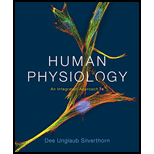
Concept explainers
a.
To define: The term “perfusion” and explain its significance in relation to cardiovascular physiology.
Introduction: Living organisms needs different systems that are properly functioning for a healthy living. Cardiovascular system is one such very important system that is required by living organisms. Defects in any part of the cardiovascular system can cause different types of disease.
b.
To define: The term “colloid osmotic pressure” and explain its significance in relation to cardiovascular physiology.
Introduction: Cardiovascular is one of the most important systems in humans. Comprised of heart, blood, and blood vessels, this system is important for transport of oxygen and other nutrients to all the cells in the body.
c.
To define: The term “vasoconstriction” and explain its significance in relation to cardiovascular physiology.
Introduction: Cardiovascular system is important for transport of different nutrients through the body. blood carries oxygen and other nutrients to different cells in the body. changes or improper functioning of any part of cardiovascular system causes different health issues.
d.
To define: The term “angiogenesis” and explain its significance in relation to cardiovascular physiology.
Introduction: Cardiovascular system comprises of solid functioning heart along with liquid connective tissue called blood. Hormones, oxygen and other important nutrients are transported to every cell of the body through the cardiovascular system.
e.
To define: The term “metarterioles” and explain its significance in relation to cardiovascular physiology.
Introduction: The cardiovascular system includes blood, blood vessels, and heart. the most important function of cardiovascular system is transportation of important gases such as oxygen and hormones along with nutrients throughout the body.
f.
To define: The term “pericytes” and explain its significance in relation to cardiovascular physiology.
Introduction:. Transportation of gases like oxygen and hormones is done by the cardiovascuklar system. The cardiovascular system is made up of the blood, blood vessels, and the heart. this system also collects waste material from all over the body and filters it in the kidneys.
Want to see the full answer?
Check out a sample textbook solution
Chapter 15 Solutions
EBK HUMAN PHYSIOLOGY
- 12. Calculate the area of a circle which has a radius of 1200 μm. Give your answer in mm² in scientific notation with the correct number of significant figures.arrow_forwardDescribe the image quality of the B.megaterium at 1000X before adding oil? What does adding oil do to the quality of the image?arrow_forwardWhich of the follwowing cells from this lab do you expect to have a nucleus and why or why not? Ceratium, Bacillus megaterium and Cheek epithelial cells?arrow_forward
- 14. If you determine there to be debris on your ocular lens, explain what is the best way to clean it off without damaging the lens?arrow_forward11. Write a simple formula for converting mm to μm when the number of mm's is known. Use the variable X to represent the number of mm's in your formula.arrow_forward13. When a smear containing cells is dried, the cells shrink due to the loss of water. What technique could you use to visualize and measure living cells without heat-fixing them? Hint: you did this technique in part I.arrow_forward
- 10. Write a simple formula for converting μm to mm when the number of μm's are known. Use the variable X to represent the number of um's in your formula.arrow_forward8. How many μm² is in one cm²; express the result in scientific notation. Show your calculations. 1 cm = 10 mm; 1 mm = 1000 μmarrow_forwardFind the dental formula and enter it in the following format: I3/3 C1/1 P4/4 M2/3 = 42 (this is not the correct number, just the correct format) Please be aware: the upper jaw is intact (all teeth are present). The bottom jaw/mandible is not intact. The front teeth should include 6 total rectangular teeth (3 on each side) and 2 total large triangular teeth (1 on each side).arrow_forward
- Answer iarrow_forwardAnswerarrow_forwardcalculate the questions showing the solution including variables,unit and equations all the questiosn below using the data a) B1, b) B2, c) hybrid rate constant (1) d) hybrid rate constant (2) e) t1/2,dist f) t1/2,elim g) k10 h) k12 i) k21 j) initial concentration (C0) k) central compartment volume (V1) l) steady-state volume (Vss) m) clearance (CL) AUC (0→10 min) using trapezoidal rule n) AUC (20→30 min) using trapezoidal rule o) AUCtail (AUC360→∞) p) total AUC (using short cut method) q) volume from AUC (VAUC)arrow_forward
 Human Physiology: From Cells to Systems (MindTap ...BiologyISBN:9781285866932Author:Lauralee SherwoodPublisher:Cengage Learning
Human Physiology: From Cells to Systems (MindTap ...BiologyISBN:9781285866932Author:Lauralee SherwoodPublisher:Cengage Learning Medical Terminology for Health Professions, Spira...Health & NutritionISBN:9781305634350Author:Ann Ehrlich, Carol L. Schroeder, Laura Ehrlich, Katrina A. SchroederPublisher:Cengage Learning
Medical Terminology for Health Professions, Spira...Health & NutritionISBN:9781305634350Author:Ann Ehrlich, Carol L. Schroeder, Laura Ehrlich, Katrina A. SchroederPublisher:Cengage Learning Comprehensive Medical Assisting: Administrative a...NursingISBN:9781305964792Author:Wilburta Q. Lindh, Carol D. Tamparo, Barbara M. Dahl, Julie Morris, Cindy CorreaPublisher:Cengage Learning
Comprehensive Medical Assisting: Administrative a...NursingISBN:9781305964792Author:Wilburta Q. Lindh, Carol D. Tamparo, Barbara M. Dahl, Julie Morris, Cindy CorreaPublisher:Cengage Learning Human Biology (MindTap Course List)BiologyISBN:9781305112100Author:Cecie Starr, Beverly McMillanPublisher:Cengage LearningBasic Clinical Lab Competencies for Respiratory C...NursingISBN:9781285244662Author:WhitePublisher:Cengage
Human Biology (MindTap Course List)BiologyISBN:9781305112100Author:Cecie Starr, Beverly McMillanPublisher:Cengage LearningBasic Clinical Lab Competencies for Respiratory C...NursingISBN:9781285244662Author:WhitePublisher:Cengage





